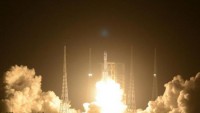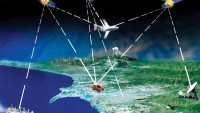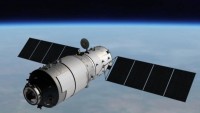China Orbits Anti-Satellite Weapon Disguised as Trash Collection Satellite
| Arthur Dominic Villasanta | | Jun 30, 2016 12:35 AM EDT |
(Photo : US Navy) Anti-satellite weapon launch from a U.S. Navy cruiser
Suspicions are being raised that a "harmless" satellite China claims will remove space junk from low Earth orbit (LEO) is in reality China's newest and stealthiest anti-satellite weapon (ASAT) that can disable U.S. military satellites without blowing them up.
Aolong-1 or Roaming Dragon was one of two secret satellites identified only as "ADRV" and "BPV" lofted into LEO during the maiden launch of China's new Long March-7 (LM-7) heavy rocket on June 25. China made no prior mention of Aolong-1 as among the payloads aboard LM-7, leading to speculation this small satellite is a military satellite with a military mission as part of China's ongoing campaign to militarize space.
Like Us on Facebook
China only announced LM-7 carried into orbit a prototype capsule for China's future next generation crew vehicle (NGCV); a CubeSat; ADRV, BPV and a block of ballast.
The China Aerospace Science and Technology Corporation said Aolong-1 is equipped with a robotic arm to remove large hunks of orbiting space debris such as old satellites. Weighing only a few hundred kilograms, Aolong-1 is just the first in a spacecraft class that will collect space debris in the future.
An unnamed researcher with the National Astronomical Observatories in Beijing, however, was quoted in the media as saying Aolong-1 isn't what it seems since it also has the potential to be used as an ASAT.
The source said it's "unrealistic" to remove the millions of pieces of space debris with robot spacecraft. Further evidence Aolong-1 has a military mission is its small size that makes it easy to build dozens of this weapon.
The technological challenge of identifying, maneuvering close to and grabbing a specific piece of tumbling space junk flashing by at thousands of kilometers per hour is impossible with existing Chinese technology.
As part of its disguise, Aolong-1 will do its advertised job of trying to remove space junk. In wartime, however, Aolong-1 will revert to its true purpose as a "Clean ASAT" that won't explode close to its target U.S. satellite but will instead nudge the target satelite so it either deviates from its current orbit or falls to Earth as flaming debris.
NASA estimates there are some 20,000 pieces of space trash larger than a softball orbiting the Earth. There are more than 10 million man-made pieces of debris orbiting the planet.
TagsAolong-1, Long March 7, China Aerospace Science and Technology Corporation, anti-satellite weapon, ASAT
©2015 Chinatopix All rights reserved. Do not reproduce without permission
EDITOR'S PICKS
-

Did the Trump administration just announce plans for a trade war with ‘hostile’ China and Russia?
-

US Senate passes Taiwan travel bill slammed by China
-

As Yan Sihong’s family grieves, here are other Chinese students who went missing abroad. Some have never been found
-

Beijing blasts Western critics who ‘smear China’ with the term sharp power
-

China Envoy Seeks to Defuse Tensions With U.S. as a Trade War Brews
-

Singapore's Deputy PM Provides Bitcoin Vote of Confidence Amid China's Blanket Bans
-

China warns investors over risks in overseas virtual currency trading
-

Chinese government most trustworthy: survey
-

Kashima Antlers On Course For Back-To-Back Titles
MOST POPULAR
LATEST NEWS
Zhou Yongkang: China's Former Security Chief Sentenced to Life in Prison

China's former Chief of the Ministry of Public Security, Zhou Yongkang, has been given a life sentence after he was found guilty of abusing his office, bribery and deliberately ... Full Article
TRENDING STORY

China Pork Prices Expected to Stabilize As The Supplies Recover

Elephone P9000 Smartphone is now on Sale on Amazon India

There's a Big Chance Cliffhangers Won't Still Be Resolved When Grey's Anatomy Season 13 Returns

Supreme Court Ruled on Samsung vs Apple Dispute for Patent Infringement

Microsoft Surface Pro 5 Rumors and Release Date: What is the Latest?













